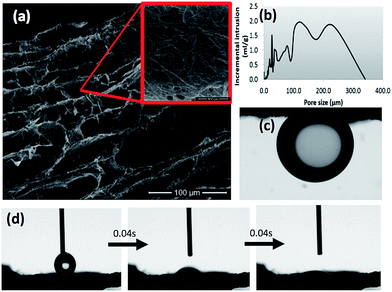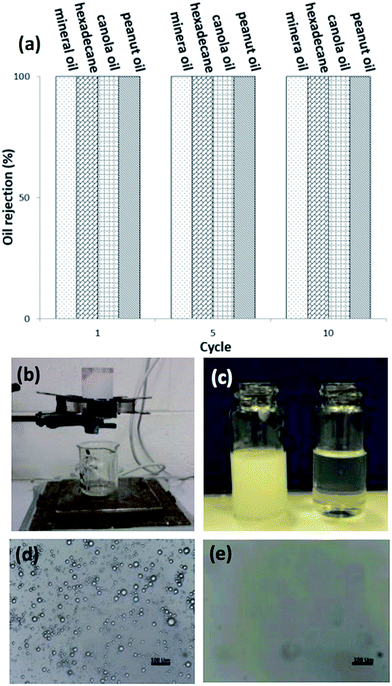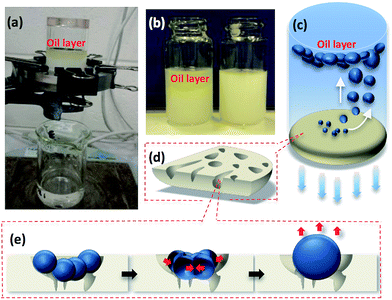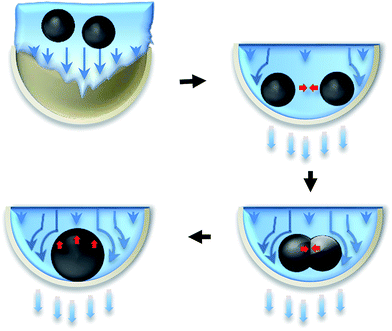Cellulose nanofibre aerogel filter with tuneable pore structure for oil/water separation and recovery†
Zhiyong He,
Xiwang Zhang* and
Warren Batchelor*
Department of Chemical Engineering, Monash University, Melbourne, VIC3800, Australia. E-mail: warren.batchelor@monash.edu; xiwang.zhang@monash.edu
First published on 15th February 2016
Abstract
A cellulose nanofibre aerogel filter with tuneable pore structure exhibiting super-hydrophilic and underwater-super-oleophobic behaviours is synthesized by a facile method of cross-linking between cellulose nanofibres and polyamideamine-epichlorohydrin (PAE). The prepared aerogel filter showed excellent oil/water separation efficiency for both oil/water mixtures (100%, even after 10 cycles), and oil/water surfactant-free emulsion (98.6%), which is driven solely by gravity. In addition, the specific structure can de-emulsify oil/water emulsion. The results showed that the cellulose aerogel filter can be used for oil/water separation and recovery.
With the rapid industrial growth, a large amount of oily wastewater is generated daily in many industries such as oil and gas, petrochemical, pharmaceutical, metallurgical and food processing industries.1 Traditional techniques for oil/water separation including flotation,2–4 biological treatment5,6 and coagulation,7–9 are either energy or chemical-intensive or not applicable to the separation of oil/water emulsions.10,11 Recently, increasing attention has been paid to hydrophobic/oleophilic materials for oil/water separation particularly via absorption.12–14 However, they are still faced with some challenges.14–16 Firstly, they absorb both water and oil during separation, limiting both selectivity and efficiency. Second, they are restricted by the oil fouling and clogging in the pore structures, reducing absorption capacity and fluid flux. Moreover, these materials can easily cause secondary pollution as the absorbed oils, especially those with high viscosity are hard to clear during post-treatments.17 Furthermore, the recovery of the oil absorbed in these materials is still difficult.18 Consequently, these factors are slowly moving researchers' interest away from hydrophobic/oleophilic materials towards hydrophilic/oleophobic materials in oil/water separation.19 Many existing hydrophilic/oleophobic materials are fabricated using petroleum-derived materials, and modified using harmful chemicals such as those with fluoride groups to gain oleophobic properties.20–22 Therefore, there is still large room for improvement to minimize their environmental impact.
Cellulose is a bio-derived material that is abundant, environmentally friendly and renewable.23 With the preponderance of hydroxyl functional groups, cellulose possesses a strong affinity to water.24 Along with the advantages mentioned above, the hydrophilic nature of cellulose makes it attractive for the design of materials with underwater super-oleophobic properties. In this paper, we demonstrate an aerogel filter, which was fabricated using cellulose nanofibres, with existing applications in ultrafiltration.25 The prepared aerogel shows excellent super-hydrophilicity and underwater super-oleophobicity leading to excellent performance in the separation of both oil/water layered mixture and oil-in-water emulsion. Fig. 1 shows the synthesis procedure of the cellulose aerogel. Cellulose nanofibres were first mixed with polyamideamine-epichlorohydrin (PAE) forming a well-dispersed suspension. The cellulose nanofibre/PAE suspension was then freeze-dried, followed by heating at 120 °C to promote cross-linking between cellulose nanofibres and PAE (refer to S2† for more details). The reaction mechanism between azetidinium groups of PAE and carboxyl group of cellulose nanofibres reinforces the cellulose aerogel. More importantly, the formation of the water-insoluble PAE networks prevent the fibre-bond detachment of PAE-cross-linked cellulose aerogel re-wetted in water. These lead to wet-strength development of the cellulose aerogel filter, making it suitable material to be used underwater.26 The pore structure of the aerogels can be easily tailored by altering the initial solids content in the cellulose suspension before freeze-drying.
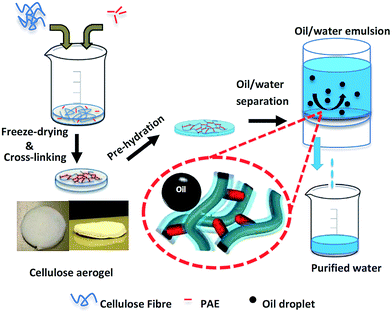 | ||
| Fig. 1 Schematic of fabrication process of the cellulose aerogel filter and its application in oil/water separation. | ||
The cross-sectional morphology and structure of the cellulose aerogel were characterized using scanning electron microscopy (SEM) and mercury porosimetry, as shown in Fig. 2a and b, respectively. The structure is composed of many nanofibre layers, in between which, there are pores with sizes ranging from 0 up to 300 μm, as shown in Fig. 2b. The wettability of water and oil on the cellulose aerogel was also characterized. The oil contact angle (155.6 °C ± 2.5 °C) on the cellulose aerogel indicates high oleophobicity. It was measured by placing 3 μl of oil on the surface of the cellulose aerogel underwater (Fig. 2c). The cellulose aerogel also exhibits super-hydrophilicity with a contact angle of almost 0 °C for water in air (Fig. 2d).
The separation efficiency of the cellulose aerogel filter for oil/water driven only by gravity was tested in the set up shown in Fig. 3b and S2.† For separation of oil/water-layered mixture, four types of oil, namely mineral oil, hexadecane, canola oil and peanut oil were tested (Movie S1†). The prepared cellulose aerogel can achieve almost 100% rejection of all these oils, even after 10 cycles (Fig. 3a, also refer to S4 and Movie S2† for recovery or aerogel between cycles). It is worth noting that due to the cross-linking by PAE, the cellulose aerogel possesses high wet strength (S7†) and durability underwater. The separation efficiency of the cellulose aerogel filter was further evaluated using oil/water emulsion (Movie S3†). Fig. 3c shows the comparison between the oil/water emulsion (left) and the filtrate collected (right).
The significant change in colour and light transmission between the two samples indicates the excellent separation efficiency. The microscope image shows that the oil/water emulsion contains a large amount of oil droplets of several microns in diameter (Fig. 3d). In comparison, the filtrate collected barely contains any oil droplet (Fig. 3e).
In addition, gravimetric analysis was also used to quantify the oil rejection. The oil rejection (R%) was calculated as follows:
| R(%) = (1 − Cf/C0) × 100 | (1) |
The pore structures of the cellulose aerogels can be controlled by altering the solids content in the cellulose suspension before freeze-drying. As shown in Fig. S5,† higher solids content in cellulose suspension results in a more compact pore structure. The effect of pore structures on deionized (DI) water flux (S3†) and oil rejection to oil-in-water emulsion were also evaluated. Aerogel with cellulose nanofiber concentration of 0.0197 g ml−1 had a DI water flux of 27![[thin space (1/6-em)]](https://www.rsc.org/images/entities/char_2009.gif) 022 LMH, but only 56.3% oil rejection, due to its relatively loose pore structure. By contrast, the aerogel prepared with cellulose nanofiber concentration of 0.0337 g ml−1 had a much lower DI water flux (2405 LMH), but excellent oil rejection (98.6%) due to its more compact pore structure (S5†). Clearly, there is a trade-off between flux and oil rejection as the pore structure of the cellulose aerogel changes. Therefore, taking advantage of the tuneable pore structure, this type of cellulose aerogel can be tailored to separate oil droplets with various sizes from water while achieving an optimal fluid flux.
022 LMH, but only 56.3% oil rejection, due to its relatively loose pore structure. By contrast, the aerogel prepared with cellulose nanofiber concentration of 0.0337 g ml−1 had a much lower DI water flux (2405 LMH), but excellent oil rejection (98.6%) due to its more compact pore structure (S5†). Clearly, there is a trade-off between flux and oil rejection as the pore structure of the cellulose aerogel changes. Therefore, taking advantage of the tuneable pore structure, this type of cellulose aerogel can be tailored to separate oil droplets with various sizes from water while achieving an optimal fluid flux.
Fig. 4a shows the separation testing for oil/water emulsion after approximately half the original volume had been filtered. Surprisingly, the well-dispersed oil-in-water emulsion had developed a de-emulsified oil layer on top, as shown by light yellow colour appearing at the top. By contrast, the original emulsion remained stable and no separate layer was formed if left alone (Fig. 4b) for equal amount of time. This indicates that the separation process by the aerogel filter de-emulsified the stable oil/water emulsion (Fig. 4c). This may be attributed to the specific structure of the cellulose nanofibre aerogel. At the surface of the hydrated cellulose aerogel, small oil droplets do not wet the surface because of the hydration layer surrounding the nanofibres. Owing to the pothole-like surface structure of the cellulose aerogel (Fig. 4d, also refer to S1† for SEM images), the small oil droplets are trapped in the voids on the surface while the continuous phase (water) is passing through the walls of the voids. The flowing motion of the continuous phase eventually results in the accumulation of small oil droplets inside the void. The small droplets are then pulled together, coalescing to form a single droplet, large enough to rise out of the continuous phase (water) due to the increasing buoyancy force (Fig. 4e).
Over the course of this process, two colliding oil droplets are initially kept apart by various interactions in between them.27 The inertia effects in the viscous flow around the droplets originate a shear-lift force perpendicular to the direction of the flow,28 as shown in Fig. 5. This shear-lift force acts externally on both droplets, counteracting these interactions. This results in the collision, hence the coalescence of the droplets.
As described by Spicer,29 the coalescence of two droplets is initiated when a liquid neck forms between them. The droplets being pulled together are then combined via flow of oil through the liquid neck. As the coalescence proceeds, the neck radius of the coalescing structure gradually increases, and the interfacial tension eventually drives it into a sphere droplet to achieve a minimization of the surface-to-volume ratio.30 The newly formed single droplet will have a larger diameter, which results in larger buoyancy force. Once the buoyancy force of the oil droplet is greater than the sum of drag and gravitational forces, the oil droplet will start floating upwards. We estimated that at a fluid velocity of 6.7 × 10−4 m s−1, the minimum diameter required for a coalesced oil droplet to float upwards is about 89 μm (refer to S6† for detailed calculations). This means that coalescence of a number of the original droplets are needed to form oil droplets with large enough diameter to float.
Conclusions
In summary, we reported an aerogel filter made of bio-derived, renewable and environmental friendly cellulose nanofibres for an oil/water separation process. The aerogel can be easily fabricated on a large scale by freeze-drying cellulose suspension, followed by cross-linking with PAE. With the super-hydrophilic and underwater super-oleophobic properties, excellent wet strength and pothole-like surface structure, it allows excellent oil/water separation efficiency to not only oil/water mixture (100%, even after 10 cycles), but also oil/water surfactant-free emulsion (98.6%). We also demonstrated that the pore structure of this aerogel could be easily engineered to fulfil the need of separating oil-in-water emulsion with various droplet sizes while achieving an optimal fluid flux. The aerogel filer also caused the transformation of stable oil/water emulsion to a de-emulsified mixture, which makes oil recovery easier. In addition, the separation was solely driven by gravitational force without any external power or additional facilities.Acknowledgements
The authors acknowledged the use of facilities in Monash Centre for Electron Microscopy (MCEM). We would like to acknowledge financial support from the Australian Research Council, Australian Paper, Carter Holt Harvey, Circa, Norske Skog and Visy through the Industry Transformation Research Hub grant IH130100016. Zhiyong He would like to acknowledge MGS and FEIPRS scholarships from Monash University.Notes and references
- M. Padaki, R. S. Murali, M. Abdullah, N. Misdan, A. Moslehyani, M. Kassim, N. Hilal and A. Ismail, Desalination, 2015, 357, 197–207 CrossRef CAS.
- J. Rubio and F. Tessele, Miner. Eng., 1997, 10, 671–679 CrossRef CAS.
- J. Finch, Miner. Eng., 1995, 8, 587–602 CrossRef CAS.
- R. Clayton, G. Jameson and E. Manlapig, Miner. Eng., 1991, 4, 925–933 CrossRef.
- Q. Li, C. Kang and C. Zhang, Process Biochem., 2005, 40, 873–877 CrossRef CAS.
- W. Lan, G. Gang and W. Jinbao, J. Environ. Sci., 2009, 21, 237–242 CrossRef.
- J. Edzwald, Water Sci. Technol., 1993, 27, 21–35 CAS.
- A. Ahmad, S. Sumathi and B. Hameed, Chem. Eng. J., 2006, 118, 99–105 CrossRef CAS.
- Y. Zeng, C. Yang, J. Zhang and W. Pu, J. Hazard. Mater., 2007, 147, 991–996 CrossRef CAS PubMed.
- Y. Zhu, F. Zhang, D. Wang, X. F. Pei, W. Zhang and J. Jin, J. Mater. Chem. A, 2013, 1, 5758–5765 CAS.
- P.-C. Chen and Z.-K. Xu, Sci. Rep., 2013, 3, 2776 Search PubMed.
- H. Bi, X. Xie, K. Yin, Y. Zhou, S. Wan, L. He, F. Xu, F. Banhart, L. Sun and R. S. Ruoff, Adv. Funct. Mater., 2012, 22, 4421–4425 CrossRef CAS.
- Q. Zhu, Q. Pan and F. Liu, J. Phys. Chem. C, 2011, 115, 17464–17470 CAS.
- C. Su, Y. Xu, W. Zhang, Y. Liu and J. Li, Appl. Surf. Sci., 2012, 258, 2319–2323 CrossRef CAS.
- F. Wang, S. Lei, M. Xue, J. Ou and W. Li, Langmuir, 2014, 30, 1281–1289 CrossRef CAS PubMed.
- W. Zhang, Y. Zhu, X. Liu, D. Wang, J. Li, L. Jiang and J. Jin, Angew. Chem., Int. Ed., 2014, 53, 856–860 CrossRef CAS PubMed.
- Z. Xue, S. Wang, L. Lin, L. Chen, M. Liu, L. Feng and L. Jiang, Adv. Mater., 2011, 23, 4270–4273 CrossRef CAS PubMed.
- D. Deng, D. P. Prendergast, J. MacFarlane, R. Bagatin, F. Stellacci and P. M. Gschwend, ACS Appl. Mater. Interfaces, 2013, 5, 774–781 CAS.
- K. Rohrbach, Y. Li, H. Zhu, Z. Liu, J. Dai, J. Andreasen and L. Hu, Chem. Commun., 2014, 50, 13296–13299 RSC.
- X. Zhu, H.-E. Loo and R. Bai, J. Membr. Sci., 2013, 436, 47–56 CrossRef CAS.
- N. Kocherginsky, C. L. Tan and W. F. Lu, J. Membr. Sci., 2003, 220, 117–128 CrossRef CAS.
- Y. Wang, S. Tao and Y. An, J. Mater. Chem. A, 2013, 1, 1701–1708 CAS.
- D. Klemm, B. Heublein, H. P. Fink and A. Bohn, Angew. Chem., Int. Ed., 2005, 44, 3358–3393 CrossRef CAS PubMed.
- D. J. Gardner, G. S. Oporto, R. Mills and M. A. S. A. Samir, J. Adhes. Sci. Technol., 2008, 22, 545–567 CrossRef CAS.
- S. Varanasi, Z.-X. Low and W. J. Batchelor, Chem. Eng. J., 2015, 265, 138–146 CrossRef CAS.
- T. Obokata and A. Isogai, Colloids Surf., A, 2007, 302, 525–531 CrossRef CAS.
- I. B. Ivanov, K. D. Danov and P. A. Kralchevsky, Colloids Surf., A, 1999, 152, 161–182 CrossRef CAS.
- E. Burlutskiy and C. K. Turangan, Chem. Eng. Res. Des., 2015, 93, 48–54 CrossRef CAS.
- A. B. Pawar, M. Caggioni, R. W. Hartel and P. T. Spicer, Faraday Discuss., 2012, 158, 341–350 RSC.
- M. Wu, T. Cubaud and C.-M. Ho, Phys. Fluids, 2004, 16, L51–L54 CrossRef CAS.
Footnote |
| † Electronic supplementary information (ESI) available: Experimental details, characterization, mechanism analysis. See DOI: 10.1039/c5ra27413c |
| This journal is © The Royal Society of Chemistry 2016 |

